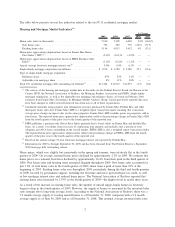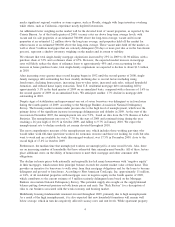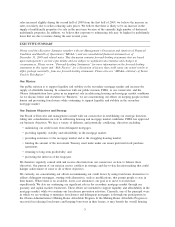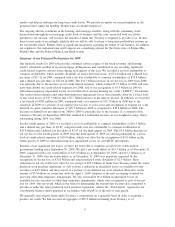Fannie Mae 2009 Annual Report Download - page 18
Download and view the complete annual report
Please find page 18 of the 2009 Fannie Mae annual report below. You can navigate through the pages in the report by either clicking on the pages listed below, or by using the keyword search tool below to find specific information within the annual report.-
 1
1 -
 2
2 -
 3
3 -
 4
4 -
 5
5 -
 6
6 -
 7
7 -
 8
8 -
 9
9 -
 10
10 -
 11
11 -
 12
12 -
 13
13 -
 14
14 -
 15
15 -
 16
16 -
 17
17 -
 18
18 -
 19
19 -
 20
20 -
 21
21 -
 22
22 -
 23
23 -
 24
24 -
 25
25 -
 26
26 -
 27
27 -
 28
28 -
 29
29 -
 30
30 -
 31
31 -
 32
32 -
 33
33 -
 34
34 -
 35
35 -
 36
36 -
 37
37 -
 38
38 -
 39
39 -
 40
40 -
 41
41 -
 42
42 -
 43
43 -
 44
44 -
 45
45 -
 46
46 -
 47
47 -
 48
48 -
 49
49 -
 50
50 -
 51
51 -
 52
52 -
 53
53 -
 54
54 -
 55
55 -
 56
56 -
 57
57 -
 58
58 -
 59
59 -
 60
60 -
 61
61 -
 62
62 -
 63
63 -
 64
64 -
 65
65 -
 66
66 -
 67
67 -
 68
68 -
 69
69 -
 70
70 -
 71
71 -
 72
72 -
 73
73 -
 74
74 -
 75
75 -
 76
76 -
 77
77 -
 78
78 -
 79
79 -
 80
80 -
 81
81 -
 82
82 -
 83
83 -
 84
84 -
 85
85 -
 86
86 -
 87
87 -
 88
88 -
 89
89 -
 90
90 -
 91
91 -
 92
92 -
 93
93 -
 94
94 -
 95
95 -
 96
96 -
 97
97 -
 98
98 -
 99
99 -
 100
100 -
 101
101 -
 102
102 -
 103
103 -
 104
104 -
 105
105 -
 106
106 -
 107
107 -
 108
108 -
 109
109 -
 110
110 -
 111
111 -
 112
112 -
 113
113 -
 114
114 -
 115
115 -
 116
116 -
 117
117 -
 118
118 -
 119
119 -
 120
120 -
 121
121 -
 122
122 -
 123
123 -
 124
124 -
 125
125 -
 126
126 -
 127
127 -
 128
128 -
 129
129 -
 130
130 -
 131
131 -
 132
132 -
 133
133 -
 134
134 -
 135
135 -
 136
136 -
 137
137 -
 138
138 -
 139
139 -
 140
140 -
 141
141 -
 142
142 -
 143
143 -
 144
144 -
 145
145 -
 146
146 -
 147
147 -
 148
148 -
 149
149 -
 150
150 -
 151
151 -
 152
152 -
 153
153 -
 154
154 -
 155
155 -
 156
156 -
 157
157 -
 158
158 -
 159
159 -
 160
160 -
 161
161 -
 162
162 -
 163
163 -
 164
164 -
 165
165 -
 166
166 -
 167
167 -
 168
168 -
 169
169 -
 170
170 -
 171
171 -
 172
172 -
 173
173 -
 174
174 -
 175
175 -
 176
176 -
 177
177 -
 178
178 -
 179
179 -
 180
180 -
 181
181 -
 182
182 -
 183
183 -
 184
184 -
 185
185 -
 186
186 -
 187
187 -
 188
188 -
 189
189 -
 190
190 -
 191
191 -
 192
192 -
 193
193 -
 194
194 -
 195
195 -
 196
196 -
 197
197 -
 198
198 -
 199
199 -
 200
200 -
 201
201 -
 202
202 -
 203
203 -
 204
204 -
 205
205 -
 206
206 -
 207
207 -
 208
208 -
 209
209 -
 210
210 -
 211
211 -
 212
212 -
 213
213 -
 214
214 -
 215
215 -
 216
216 -
 217
217 -
 218
218 -
 219
219 -
 220
220 -
 221
221 -
 222
222 -
 223
223 -
 224
224 -
 225
225 -
 226
226 -
 227
227 -
 228
228 -
 229
229 -
 230
230 -
 231
231 -
 232
232 -
 233
233 -
 234
234 -
 235
235 -
 236
236 -
 237
237 -
 238
238 -
 239
239 -
 240
240 -
 241
241 -
 242
242 -
 243
243 -
 244
244 -
 245
245 -
 246
246 -
 247
247 -
 248
248 -
 249
249 -
 250
250 -
 251
251 -
 252
252 -
 253
253 -
 254
254 -
 255
255 -
 256
256 -
 257
257 -
 258
258 -
 259
259 -
 260
260 -
 261
261 -
 262
262 -
 263
263 -
 264
264 -
 265
265 -
 266
266 -
 267
267 -
 268
268 -
 269
269 -
 270
270 -
 271
271 -
 272
272 -
 273
273 -
 274
274 -
 275
275 -
 276
276 -
 277
277 -
 278
278 -
 279
279 -
 280
280 -
 281
281 -
 282
282 -
 283
283 -
 284
284 -
 285
285 -
 286
286 -
 287
287 -
 288
288 -
 289
289 -
 290
290 -
 291
291 -
 292
292 -
 293
293 -
 294
294 -
 295
295 -
 296
296 -
 297
297 -
 298
298 -
 299
299 -
 300
300 -
 301
301 -
 302
302 -
 303
303 -
 304
304 -
 305
305 -
 306
306 -
 307
307 -
 308
308 -
 309
309 -
 310
310 -
 311
311 -
 312
312 -
 313
313 -
 314
314 -
 315
315 -
 316
316 -
 317
317 -
 318
318 -
 319
319 -
 320
320 -
 321
321 -
 322
322 -
 323
323 -
 324
324 -
 325
325 -
 326
326 -
 327
327 -
 328
328 -
 329
329 -
 330
330 -
 331
331 -
 332
332 -
 333
333 -
 334
334 -
 335
335 -
 336
336 -
 337
337 -
 338
338 -
 339
339 -
 340
340 -
 341
341 -
 342
342 -
 343
343 -
 344
344 -
 345
345 -
 346
346 -
 347
347 -
 348
348 -
 349
349 -
 350
350 -
 351
351 -
 352
352 -
 353
353 -
 354
354 -
 355
355 -
 356
356 -
 357
357 -
 358
358 -
 359
359 -
 360
360 -
 361
361 -
 362
362 -
 363
363 -
 364
364 -
 365
365 -
 366
366 -
 367
367 -
 368
368 -
 369
369 -
 370
370 -
 371
371 -
 372
372 -
 373
373 -
 374
374 -
 375
375 -
 376
376 -
 377
377 -
 378
378 -
 379
379 -
 380
380 -
 381
381 -
 382
382 -
 383
383 -
 384
384 -
 385
385 -
 386
386 -
 387
387 -
 388
388 -
 389
389 -
 390
390 -
 391
391 -
 392
392 -
 393
393 -
 394
394 -
 395
395
 |
 |
Home Retention Strategies
In 2009, we completed home retention workouts for over 160,000 loans with an aggregate unpaid principal
balance of $27.7 billion. On a loan count basis, this represented a 43% increase over home retention workouts
completed in 2008. Loan modifications were the most significant driver of the increase in home retention
workouts from 2008 to 2009 as we experienced a shift in our approach to workouts to address the increasing
number of borrowers facing long-term, rather than short-term, financial hardships. Our loan modifications in
2009 targeted permanent changes to loan terms to further increase the likelihood of long-term home retention,
in contrast to HomeSaver Advance Loans, which are unsecured personal loans in the amount of past due
payments on a borrower’s mortgage loan used to bring the mortgage loan current. We provided fewer
HomeSaver Advance loans in 2009 than in 2008.
Not counting trial modifications under HAMP, in 2009 we completed approximately 99,000 loan
modifications, an increase of 195% over 2008. Loan modifications represented 61% of home retention
workouts completed in 2009 compared with 30% in 2008.
In 2009, the characteristics of our modifications changed notably, with 93% of modifications involving term
extensions, interest rate reductions, or a combination of both, compared with 57% in 2008. As a result,
approximately 58% of modifications completed in 2009 resulted in a reduction in initial monthly payments of
greater than 20%, compared with 13% for modifications completed in 2008. This level of payment reduction
should provide valuable assistance to borrowers in sustaining home ownership and, in turn, should help us
reduce borrower defaults, which are costly for us.
Our modification statistics do not include HAMP trial modifications until they become permanent
modifications. HAMP was our primary loan modification program in 2009; however, many of the trial
modifications entered into during 2009 have not yet converted to a permanent modification solution due to the
fact that the trial period is still underway or the trial period has been extended for servicers to obtain
documents and perform final modification underwriting. A borrower receives payment relief during the HAMP
trial period to the extent that the borrower pays according to the trial modification plan. While HAMP is the
first home retention workout that servicers must consider for borrowers, we continued to complete
modifications for those borrowers who did not qualify for HAMP, with the vast majority of our modifications
in 2009 completed through our standard modification approaches. Including HAMP trials entered into during
2009, our HAMP efforts represented the vast majority of our total foreclosure prevention actions. As of
December 31, 2009, 291,053 of our loans were in trial modification periods under HAMP, as reported by
servicers to the system of record for the program. The number of our HAMP trials increased substantially in
the third and fourth quarters of 2009, and we expect our permanent HAMP modifications to increase
significantly as trial periods are completed and permanent modification offers are extended. However, it is
difficult to predict how many trial modifications for our loans under HAMP will ultimately convert to
permanent loan modifications.
Foreclosure Alternatives
If we are unable to provide a viable home retention option through HAMP or other programs, we may offer
foreclosure alternatives, including preforeclosure sales and deeds-in-lieu of foreclosure. In 2009, our total
volume of preforeclosure sales and deeds-in-lieu of foreclosures increased by 239% to approximately 40,000
in 2009 compared with approximately 12,000 in 2008. We have increasingly relied on foreclosure alternatives,
primarily preforeclosure sales and deeds-in-lieu of foreclosure, as a growing number of borrowers have faced
longer-term economic hardships that cannot be solved through a home retention solution.
Providing Mortgage Market Liquidity
In 2009, we purchased or guaranteed an estimated $823.6 billion in new business, measured by unpaid
principal balance, which included financing for approximately 3,125,000 conventional single-family loans and
approximately 372,000 multifamily units. The $823.6 billion in new single-family and multifamily business in
2009 consisted of $496.0 billion in Fannie Mae MBS acquired by third parties, and $327.6 billion in mortgage
loans and mortgage-related securities that we purchased for our mortgage investment portfolio.
13
